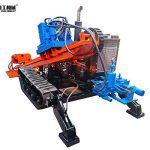Directional drilling machine for sale, also known as a horizontal directional drill (HDD), is a specialized piece of equipment designed to install underground pipelines, conduits, and cables without the need for traditional open-cut trenching. Unlike conventional drilling methods that require extensive excavation, directional drilling allows operators to bore horizontally or at controlled angles beneath obstacles such as roads, rivers, or existing infrastructure. This minimizes surface disruption, reduces environmental impact, and accelerates project timelines. It has wide applications, particularly in the installation of underground utilities such as pipelines, cables, and communication lines.
Components Of Directional Drilling Machine for Sale
Drill Rig: The primary machine that generates torque and thrust to drive the drill string.
Drill String: A series of connected rods that transmit power to the drill head.
Drill Head: The cutting tool that varies in design based on soil or rock conditions.
Tracking System: Uses electronic sensors or walk-over locators to monitor drill head position and depth.
Mud Mixing System: Circulates drilling fluid (a mix of water and bentonite) to lubricate the drill string, stabilize the borehole, and remove cuttings.
Applications Of Horizontal Directional Drilling Rig
The versatility of directional drilling machine for sale makes them indispensable across industries. Common applications include:
1. Utility Installations
Telecommunications, electrical, and gas lines are frequently installed using HDD to avoid disrupting traffic or damaging landscapes.
2. Oil And Gas Pipelines
Directional drilling enables the installation of pipelines under sensitive ecosystems or urban areas, reducing environmental and social risks.
3. Water And Sewer Systems
Municipalities use trenchless technology to upgrade aging infrastructure with minimal public disturbance.
How Does HDD Machine Work?
The directional drilling machine for sale process typically consists of three main stages:
Pilot Bore
A small-diameter pilot hole is drilled along a pre-designed path using a steerable drill head. Advanced tracking systems guide the drill bit’s direction and depth in real time.
Pre-Reaming
After the pilot hole is completed, a reamer is pulled back through the hole to enlarge it to the required diameter. This process may be repeated in stages, depending on the size of the final product pipe.
Product Pipe Installation
Finally, the product pipe or conduit is pulled through the enlarged hole from the exit to the entry point.


